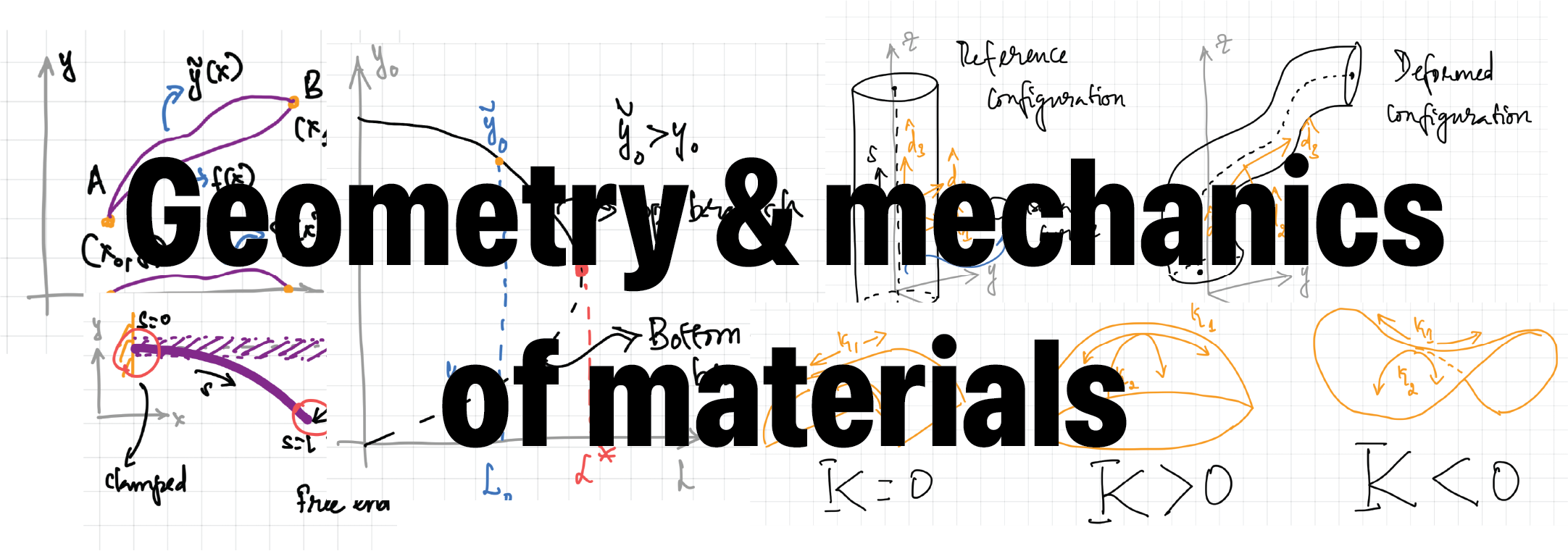
After joining IIT Madras as a faculty in the Department of Applied Mechanics I floated a new elective, AM 6023 - Geometry & mechanics of materials, that combines aspects of geometry and their relation to mechanics of materials. I tried to lure the students into registering for this course by sending out a cryptic email: "Have you ever wondered why we fold a pizza while eating? Is the mechanism at play at all related to why the human foot has a transverse arch?". I guess the question was a long shot and/or mundane for the river dwellers and I could pick the brains of only 7 naive students.
The magical number did keep the course entertaining. Uncle puns are all the rage now but I kept them aside from the course. This graduate level course aims to bring to speed students from various streams interested in a modern take on mechanics. Though modern might sound apocryphal (and pompous) to the well informed as the non-linear theories of filaments, sheets and shells are at least half a century old. However we are really seeing a surge in interest due to recent developments in computational and experimental tools to probe them.
I was pretty ambitious on what I wanted to cover in the course. My aim was to walk the stretch of mechanics starting with the mere basics of vector algebra, towards the destination being shell theories. This clearly proved to be a daydream and I had to mollify my spirits by stopping at the theory of sheets. During the course of teaching, something became evident to me. It was that I was learning way more about the subject than earlier and likely much more than my students. Thanks to the brilliant references of Landau & Lifshitz, Theory of elasticity, Audoly & Pomeau, Elasticity & Geometry and Basile Audoly's lecture notes, my job reduced to conveying the crux of the calculations presented in them. I, of course, had the freedom to choose the concepts that could be part of the lecture and the way it could be taught.
The concepts covered in the course can be classified into three categories:
- Mathematical preliminaries
- Algebra and calculus of vectors and tensors
- Calculus of variation
- Geometry of curves and surfaces
- Mechanics of filaments and sheets
- Elastica, Kirchhoff rod theory
- Membrane, Foppl-van Karman plate theory
In the process, I did make a decent set of lecture notes which in the due course I will shape into a form I am happy to share with everyone. As I have mentioned, there is little novelty in my lecture notes and that minute bit of novelty comes from stringing together the topics into a palatable platter. Broadly, the topics covered in the course are
- Scalars, Vectors in 2D, Forward and Backward transformation, Kronecker Delta
- Vector components transformation, Scalar product, Vector product, Levi-civita symbol
- 2nd-order tensor, 3rd-order tensor, Anti-symmetric tensor, Introduction to tensor calculus, Jacobian
- Tensor calculus - curl, div, gradient
- Theory of 2D curves I
- Theory of 2D curves II
- Mathematica tutorial
- Calculus of Variation I
- Calculus of Variation II
- Constrained optimization
- Mechanics of slender structures
- Elastica, Regular perturbation theory
- Non-linear cantilever beam theory, Euler Bernoulli limit
- Bifurcation diagram
- Mechanics of human hair I (Derivation of Energy, Equilibrium eqns., Non-dimensional numbers)
- Mechanics of human hair II (Phase diagram; Weak, Strong gravity)
- Boundary layer theory
- Strain tensor, Stress tensor - Properties
- Hookean elasticity, Equilibrium eqns.
- Geometry of rods in 3D - Cosserat curve, Darboux vector
- Theory of rods - Kirchhoff eqns.
- Geometry of 2D surfaces - Mean curvature, Gaussian curvature
- Theory of sheets - Membrane energy, Bending energy, Foppl-van Karman eqns.
- Geometry of Origami and Kirigami
There are a couple of things I wish I had done before wrapping up the course, which I will attempt to do the next time I teach. One is introducing the geometry of 2D surfaces using invariant representation i.e. with first and second fundamental form. Second, using this representation it is worthwhile to look at the derivation of Foppl-van Karman equations via the lens of variational calculus. In this approach one evaluates the bending and the stretching energy using the invariant form of the geometry of the deformed plate. I will try to derive the latter in a future blog post.
Overall, I am quite happy with the contents of the course (and as one white haired sage (not lavender) warned me, I did not spill any uncle puns in the class) and hope there will be more audience in the future as I feel a lot of the concepts has not yet become common parlance in a mechanics of materials course.